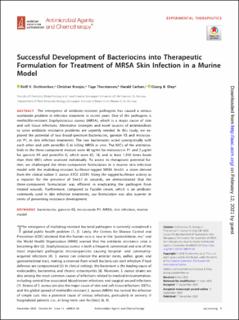| dc.contributor.author | Ovchinnikov, Kirill | |
| dc.contributor.author | Kranjec, Christian | |
| dc.contributor.author | Thorstensen, Tage | |
| dc.contributor.author | Carlsen, Harald | |
| dc.contributor.author | Diep, Dzung B. | |
| dc.date.accessioned | 2021-11-18T10:37:01Z | |
| dc.date.available | 2021-11-18T10:37:01Z | |
| dc.date.created | 2020-10-08T12:03:57Z | |
| dc.date.issued | 2020 | |
| dc.identifier.citation | Antimicrobial Agents and Chemotherapy. 2020, 64 (12), . | |
| dc.identifier.issn | 0066-4804 | |
| dc.identifier.uri | https://hdl.handle.net/11250/2830260 | |
| dc.description.abstract | The emergence of antibiotic-resistant pathogens has caused a serious worldwide problem in infection treatment in recent years. One of the pathogens is methicillin-resistant Staphylococcus aureus (MRSA), which is a major cause of skin and soft tissue infections. Alternative strategies and novel sources of antimicrobials to solve antibiotic resistance problems are urgently needed. In this study, we explored the potential of two broad-spectrum bacteriocins, garvicin KS and micrococcin P1, in skin infection treatments. The two bacteriocins acted synergistically with each other and with penicillin G in killing MRSA in vitro. The MICs of the antimicrobials in the three-component mixture were 40 ng/ml for micrococcin P1 and 2 μg/ml for garvicin KS and penicillin G, which were 62, 16, and at least 1,250 times lower than their MICs when assessed individually. To assess its therapeutic potential further, we challenged the three-component formulation in a murine skin infection model with the multidrug-resistant luciferase-tagged MRSA Xen31, a strain derived from the clinical isolate S. aureus ATCC 33591. Using the tagged-luciferase activity as a reporter for the presence of Xen31 in wounds, we demonstrated that the three-component formulation was efficient in eradicating the pathogen from treated wounds. Furthermore, compared to Fucidin cream, which is an antibiotic commonly used in skin infection treatments, our formulation was also superior in terms of preventing resistance development. | |
| dc.language.iso | eng | |
| dc.title | Successful development of bacteriocins into therapeutic formulation for treatment of MRSA skin infection in a murine model | |
| dc.type | Peer reviewed | |
| dc.type | Journal article | |
| dc.description.version | publishedVersion | |
| dc.source.pagenumber | 13 | |
| dc.source.volume | 64 | |
| dc.source.journal | Antimicrobial Agents and Chemotherapy | |
| dc.source.issue | 12 | |
| dc.identifier.doi | 10.1128/AAC.00829-20 | |
| dc.identifier.cristin | 1838180 | |
| dc.relation.project | Norges forskningsråd: 296220 | |
| dc.relation.project | Norges forskningsråd: 254784 | |
| dc.relation.project | Norges forskningsråd: 273646 | |
| cristin.ispublished | true | |
| cristin.fulltext | original | |
| cristin.qualitycode | 2 | |
